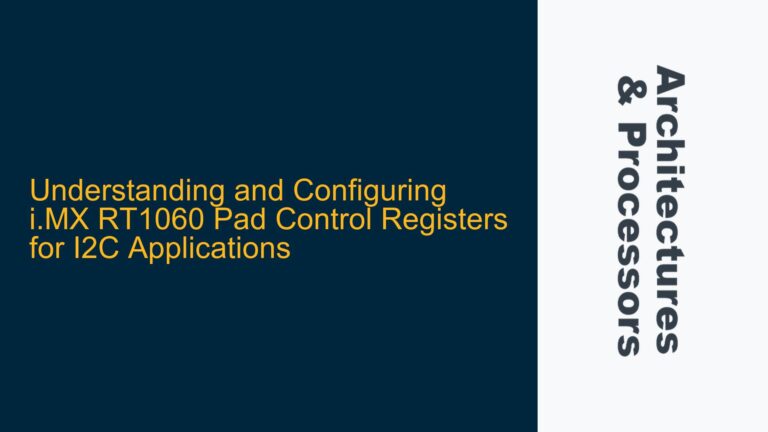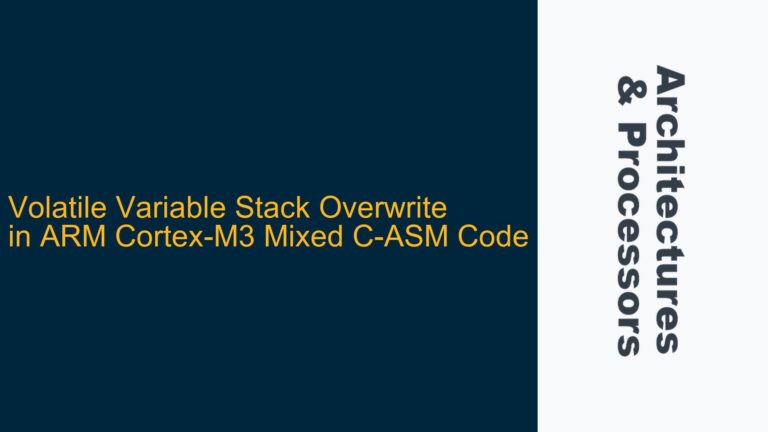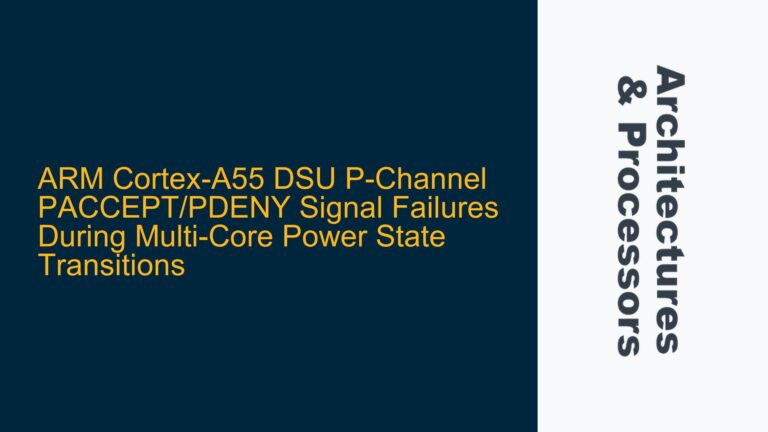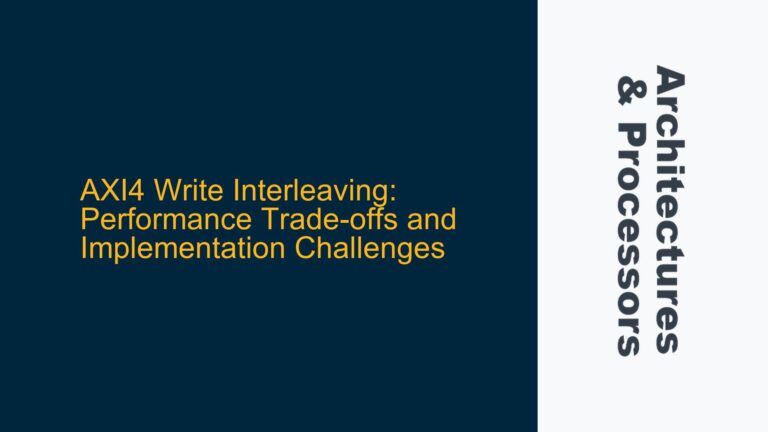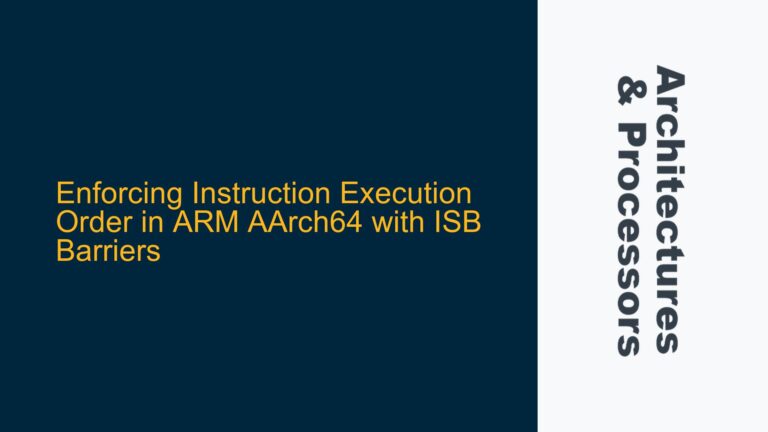ARM Cortex-A53 Instruction Prefetching Challenges in Large Code Blocks
The ARM Cortex-A53 processor, a widely used core in embedded systems and mobile devices, employs a sophisticated caching mechanism to optimize instruction and data access. However, when dealing with large blocks of code that lack function calls, ensuring efficient instruction prefetching into the L1 instruction cache (L1 I-cache) can be challenging. The primary issue revolves around the use of the PRFM (Prefetch Memory) instruction in AArch64 mode, which is designed to prefetch data or instructions into the cache hierarchy. The Cortex-A53 Technical Reference Manual (TRM) specifies that PRFM can target either the L1 or L2 cache, but the behavior and effectiveness of this instruction depend on several factors, including cache hierarchy, timing, and potential eviction policies.
In scenarios where a large block of sequential code is executed, the processor must ensure that instructions are available in the L1 I-cache to avoid stalls caused by cache misses. The Cortex-A53’s prefetching mechanism is designed to mitigate this by preloading instructions into the cache before they are needed. However, the effectiveness of this mechanism depends on how the PRFM instruction is utilized. Misuse or misunderstanding of PRFM can lead to suboptimal performance, as the prefetched instructions may be evicted before they are used or may not be loaded into the correct cache level.
The key questions that arise in this context are:
- Does the PRFM instruction check the L2 cache before fetching from main memory, or does it bypass the L2 cache entirely?
- Is it sustainable to use PRFM multiple times at specific offsets to preload instructions into the L2 cache and then later into the L1 cache?
These questions highlight the need for a deep understanding of the Cortex-A53’s cache architecture and prefetching mechanisms to ensure optimal performance.
PRFM Instruction Behavior and Cache Hierarchy Interaction
The PRFM instruction in the ARM Cortex-A53 is a powerful tool for prefetching data or instructions into the cache hierarchy. However, its behavior is nuanced and depends on the cache level targeted and the state of the cache hierarchy. The Cortex-A53 TRM states that PRFM can target the L2 cache directly, allowing a linefill request to be sent to the L2 cache without returning data to the L1 cache. This capability is particularly useful for prefetching instructions that are likely to be needed in the near future but are not immediately required.
When a PRFM instruction is executed, the processor first checks the cache level specified by the prefetch hint. If the target cache level (L1 or L2) does not contain the requested data, a linefill request is initiated to fetch the data from the next level of the memory hierarchy. For example, if the PRFM instruction targets the L2 cache and the data is not present in the L2 cache, the processor will fetch the data from main memory and store it in the L2 cache. Importantly, the PRFM instruction does not return data to the L1 cache unless explicitly requested.
The interaction between the L1 and L2 caches is critical for understanding the effectiveness of PRFM. The L1 cache is smaller and faster, while the L2 cache is larger but slower. Prefetching instructions into the L2 cache can be beneficial if the instructions are likely to be needed soon but not immediately. However, if the instructions are needed immediately, prefetching directly into the L1 cache may be more effective. The challenge lies in balancing these two approaches to minimize cache misses and maximize performance.
Another important consideration is the potential for cache eviction. The Cortex-A53 employs a least recently used (LRU) eviction policy, which means that prefetched instructions may be evicted from the cache if they are not accessed soon enough. This is particularly relevant when using PRFM to prefetch instructions far ahead of their execution. If the prefetched instructions are evicted before they are needed, the prefetching effort is wasted, and the processor may experience cache misses.
Implementing PRFM for Optimal L1 and L2 Cache Utilization
To effectively use the PRFM instruction for prefetching instructions into the L1 and L2 caches, developers must consider several factors, including the timing of prefetch requests, the target cache level, and the potential for cache eviction. The following steps outline a systematic approach to optimizing instruction prefetching in the Cortex-A53:
-
Determine the Optimal Prefetch Distance: The prefetch distance refers to how far ahead of the current execution point instructions should be prefetched. Prefetching too far ahead increases the risk of cache eviction, while prefetching too close to the execution point may not provide enough time for the instructions to be loaded into the cache. Experimentation and profiling are essential to determine the optimal prefetch distance for a given application.
-
Target the Appropriate Cache Level: The PRFM instruction allows developers to specify the target cache level (L1 or L2). Prefetching into the L2 cache is useful for instructions that are likely to be needed soon but not immediately, while prefetching into the L1 cache is more appropriate for instructions that will be needed immediately. Developers should carefully consider the access patterns of their code to determine the most effective cache level for prefetching.
-
Use Multiple PRFM Instructions Strategically: In some cases, it may be beneficial to use multiple PRFM instructions at specific offsets to preload instructions into the L2 cache and then later into the L1 cache. This approach can help ensure that instructions are available in the L1 cache when needed while minimizing the risk of cache eviction. However, developers must be cautious not to overuse PRFM, as excessive prefetching can lead to cache pollution and reduced performance.
-
Monitor Cache Performance: Profiling tools and performance counters can provide valuable insights into the effectiveness of prefetching strategies. Developers should monitor cache hit rates, miss rates, and eviction rates to identify potential bottlenecks and optimize their prefetching approach.
-
Consider System-Level Factors: The effectiveness of instruction prefetching can be influenced by system-level factors such as memory bandwidth, contention for cache resources, and the presence of other applications or processes. Developers should consider these factors when designing and optimizing their prefetching strategies.
By following these steps, developers can effectively use the PRFM instruction to optimize instruction prefetching in the ARM Cortex-A53, ensuring that instructions are available in the L1 and L2 caches when needed and minimizing the risk of cache misses. This approach can lead to significant performance improvements in applications with large blocks of sequential code.
In conclusion, the ARM Cortex-A53’s prefetching mechanism, when used correctly, can significantly enhance performance by ensuring that instructions are available in the cache hierarchy when needed. However, achieving optimal performance requires a deep understanding of the cache architecture, careful consideration of prefetching strategies, and ongoing monitoring and optimization. By following the guidelines outlined in this post, developers can effectively leverage the PRFM instruction to maximize the efficiency of their Cortex-A53-based systems.

